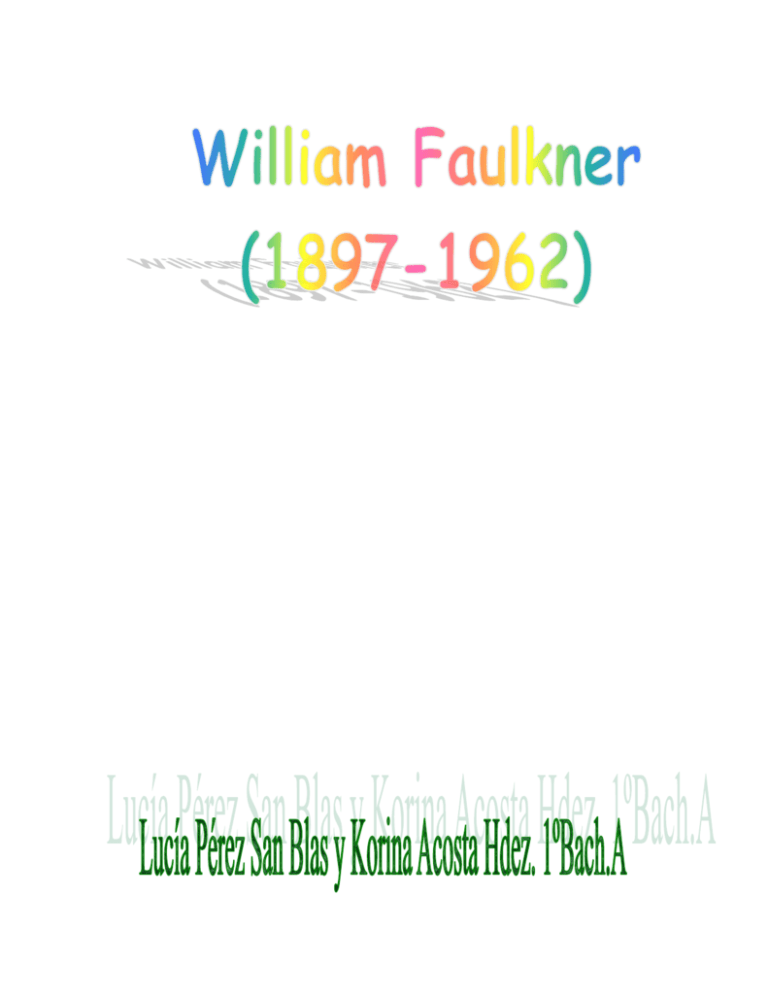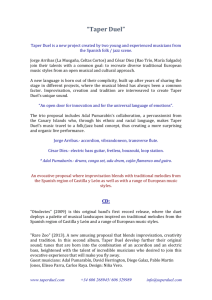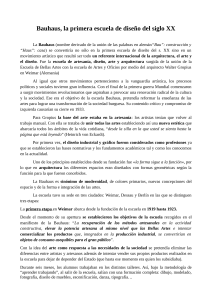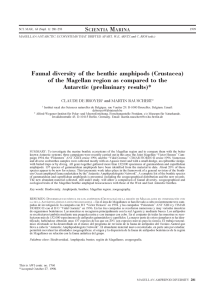William Faulkner – Biography(English)
advertisement

Biography in English Biography in Spanish Society of his epoch World events along his life His more important works Some photos Personal opinion William Faulkner – Biography (English) William Faulkner (1897-1962), who came from an old southern family, grew up in Oxford, Mississippi. He joined the Canadian, and later the British, Royal Air Force during the First World War, studied for a while at the University of Mississippi, and temporarily worked for a New York bookstore and a New Orleans newspaper. Except for some trips to Europe and Asia, and a few brief stays in Hollywood as a scriptwriter, he worked on his novels and short stories on a farm in Oxford. In an attempt to create a saga of his own, Faulkner has invented a host of characters typical of the historical growth and subsequent decadence of the South. The human drama in Faulkner's novels is then built on the model of the actual, historical drama extending over almost a century and a half .Each story and each novel contributes to the construction of a whole, which is the imaginary Yoknapatawpha County and its inhabitants. Their theme is the decay of the old South, as represented by the Sartoris and Compson families, and the emergence of ruthless and brash newcomers, the Snopeses. Theme and technique - the distortion of time through the use of the inner monologue are fused particularly successfully in The Sound and the Fury (1929), the downfall of the Compson family seen through the minds of several characters. The novel Sanctuary (1931) is about the degeneration of Temple Drake, a young girl from a distinguished southern family. Its sequel, Requiem For A Nun (1951), written partly as a drama, centred on the courtroom trial of a Negro woman who had once been a party to Temple Drake's debauchery. In Light in August (1932), prejudice is shown to be most destructive when it is internalized, as in Joe Christmas, who believes, though there is no proof of it, that one of his parents was a Negro. The theme of racial prejudice is brought up again in Absalom, Absalom! (1936), in which a young man is rejected by his father and brother because of his mixed blood. Faulkner's most outspoken moral evaluation of the relationship and the problems between Negroes and whites is to be found in Intruder In the Dust (1948). In 1940, Faulkner published the first volume of the Snopes trilogy, The Hamlet, to be followed by two volumes, The Town (1957) and The Mansion (1959), all of them tracing the rise of the insidious Snopes family to positions of power and wealth in the community. The reivers, his last - and most humorous - work, with great many similarities to Mark Twain's Huckleberry Finn, appeared in 1962, the year of Faulkner's death. From Nobel Lectures, Literature 1901-1967, Editor Horst Frenz, Elsevier Publishing Company, Amsterdam, 1969 This autobiography/biography was written at the time of the award and later published in the book series Les Prix Nobel/Nobel Lectures. The information is sometimes updated with an addendum submitted by the Laureate. To cite this document, always state the source as shown above. William Faulkner died on July 6, 1962. Guillermo Faulkner – Biografía (español) Guillermo Faulkner (1897-1962), que vino de una vieja familia meridional, creció para arriba en Oxford, Mississippi. Él ensambló el canadiense, y más adelante la fuerza aérea británica, real durante la primera guerra mundial, estudiada durante algún tiempo en la universidad de Mississippi, y trabajada temporalmente para una librería de Nueva York y un periódico de New Orleans. A excepción de algunos viajes a Europa y a Asia, y de algunas breve estancias en Hollywood como scriptwriter, él trabajó en sus novelas e historias cortas en una granja en Oxford. En un intento por crear una saga sus el propios, Faulkner ha inventado un anfitrión de los caracteres típicos del crecimiento histórico y de la decadencia subsecuente del sur. El drama humano en las novelas de Faulkner entonces se construye en el modelo del real, el excedente que extiende del drama histórico casi un siglo y una mitad de cada historia y cada novela contribuye a la construcción de un conjunto, que es el condado imaginario de Yoknapatawpha y sus habitantes. Su tema es el decaimiento del viejo sur, según lo representado por las familias de Sartoris y de Compson, y la aparición de los recién llegado despiadados y temerarios, el Snopeses. Tema y técnica - la distorsión del tiempo con el uso del monólogo interno está fundida particularmente con éxito en el sonido y la furia (1929), la caída de la familia de Compson considerada con las mentes de varios caracteres. La novela Sanctuary (1931) está sobre la degeneración del templo Drake, muchacha joven de una familia meridional distinguida. Su consecuencia, Requiem para una monja (1951), escrito en parte como drama, centrado en el ensayo de la sala de tribunal de una mujer del negro que había sido una vez un partido al debauchery de Drake del templo. En luz en agosto (1932), el prejudicar se demuestra para ser el más destructivo cuando se interna, como de Navidad de Joe, que cree, aunque no hay prueba de ella, que uno de sus padres era un negro. ¡El tema del prejudicar racial se trae para arriba otra vez en Absalom, Absalom! (1936), en que su padre y hermano rechaza a un hombre joven debido a su sangre mezclada. La evaluación moral más abierta de Faulkner de la relación y de los problemas entre los negros y los blancos debe ser encontrada en intruso en el polvo (1948). En 1940, Faulkner publicó el primer volumen de la trilogía de Snopes, la aldea, para ser seguido por dos volúmenes, la ciudad (1957) y la mansión (1959), todas que remontaban a la subida de la familia insidiosa de Snopes a las posiciones de la energía y de la abundancia en la comunidad. Los reivers, su último - y el más chistoso - trabajan, con grande muchas semejanzas marcar el arándano Finn de Twain, aparecido en 1962, el año de la muerte de Faulkner. De las conferencias Nobel, literatura 1901-1967, Editor Horst Frenz, Elsevier Publishing Company, Amsterdam, 1969 Esta autobiografía/biografía fue escrita a la hora de la concesión y publicada más adelante en la serie Les Prix Nobel del libro/las conferencias Nobel. La información se pone al día a veces con una adición sometida por el laureado. Para citar este documento, indicar siempre la fuente como se muestra arriba. Guillermo Faulkner muerto el 6 de julio de 1962. The William Faulkner Society is dedicated to fostering the study of Faulkner from all perspectives and to promoting research, scholarship, and criticism dealing with his writings and their place in literature. The Society sponsors regular panels at MLA and ALA, and holds its annual meetings at the American Literature Association and Modern Language Association Conferences. It is affiliated with The Faulkner Journal. Membership is open to anyone interested in the writer and his work. Membership Information Officers of the Society Upcoming Events and Calls for Papers Scholarships, Fellowships, and Awards The Faulkner Discussion List Related Faulkner Sites Archives · 1897 Is murdered Cánovas of the Castle. · 1898 War with the USA and loss of the last colonies of overseas. · 1909 tragic Week of Barcelona. · 1912 Canalejas's Murder. · 1914 The First world war. · 1917 Russian Revolution. · 1921 Annual's Disaster. · 1923 Dictatorship of Cousin of Rivera. · 1929 Crack of the bag(stock exchange). · 1931 The Second Republic. · 1936 Civil war. · 1939 Invasion of Poland for Hitler's troops, with which it is considered initiated the World War II followed(continued) of the occupation of Paris in 1940. · 1941 USA it(he,she) enters the war. · 1945 Finishes the Second world war, with the throwing of atomic bombs on Hiroshima and Nagasaki. Between(among) the first one and the second one it is calculated that they could die near 100 million persons. · 1949 Communism in China with Mao. · 1955 Independence of Morocco. · 1958 Fidel Castro heads the Cuban revolution. Novels: Soldiers Pay (1926) Mosquitoes (1927} Sartoris (1929) The noise and the fury (1929) While I bother (1930) Sanctuary (1931) Light of August (1932) The wild palms (1933), Pylon (1935) Absalom, Absalom (1936) The Unvanquished (1938) If I Forget Thee Jerusalem (1939) The Hamlet (1940) Go Down, Moses (1942) Intruder in the Dust (1948) Requiem for to Nun (1951) To Fable (1954) The Town (1957) The Mansion (1959) The Reavers (1962) Flags in the Dust (1973) Short histories " Landing in Luck " (1919) "The Hill" (1922) " Mirrors of Chartres Street " (1925) " Damon and Pythias Unlimited " (1925) "Jealousy" (1925) "Cheest" (1925) " Out of Nazareth " (1925) " The Kingdom of God " (1925) "The Rosary" (1925) "The Cobbler" (1925) "Chance" (1925) "Sunset" (1925) " The Kid Learns " (1925) "The Liar" (1925) "Home" (1925) "Episode" (1925) "Country Mice" (1925) " I Ho and Two Bottles of Rum " (1925) " To Rose for Emily " (1930) "Honor" (1930) "Thrift" (1930) Leaves " (1930) "Ad Astra" (1931) "Dry September" (1931) " That Evening Sun " (1931) "Hair" (1931) "Spotted Horses" (1931) "The Hound" (1931) "Fox Hunt" (1931) Carcassonne (1931) Collections of poetry Vision in Spring (1921) The Marble Faun (1924) This Earth, to Poem (1932) To Green Bough (1965) Mississippi Poems (1979) Helen, to Courtship and Mississippi Poems (1981) Scripts for cinema Today We Live (1933) The Road to Glory (1936) Slave Ship (1937) Gunga Din (1939) To Have and Have Not (1944) The Southerner (1945) The Big Sleep (1946) Land of the Pharaohs (1955) The Portable Faulkner William Faulkner - Biography & Autobiography - 2003 - 688 pages Contents INTRODUCTION BY MALCOLM COWLEY Vii BOOKS BY WILLIAM FAULKNER William Faulkner's Absalom, Absalom Carol Siri Johnson, Laurie Kalmanson, William Faulkner - Study Aids - 1996 - 96 pages ONE Introduction The Lift and Work of William Faulkner William Faulkner is arguably one of the greatest American writers from the South. Rad Tech's Guide to Mri: Basic Physics, Instrumentation and Quality Control William Faulkner - Technology - 2001 - 101 pages TABLE ... OF ... CONTENTS 1 Hardware Overview, I Instrumentation: Magnets, I Instrumentation Radio-Frequency Subsystem Conversations With William Faulkner M Thomas Inge - Biography & Autobiography - 1999 - 356 pages Books by William Faulkner The Marble Faun. Boston: The Four Seas Company, 1925. Soldiers' Pay. New York: Born & Liveright, 1926. Mosquitoes. William Faulkner: The Yoknapatawpha Country Cleanth Brooks - Literary Criticism - 1990 - 499 pages Faulkner the Provincial MOST READERS associate William Faulkner with the South quite as automatically as they associate Thomas Hardy with Wessex. To begin, we believe that this work has favored us very much, so much to us as to our companions, since we have known important prominent figures of the world culture that before we did not know. Especially we have liked our author more than we were imagining, because apparently he was very important and to acquire culture never comes badly. We wait that the year that comes sigams doing this type of activities which enrich enough our vocabulary the use to diary of the English.



